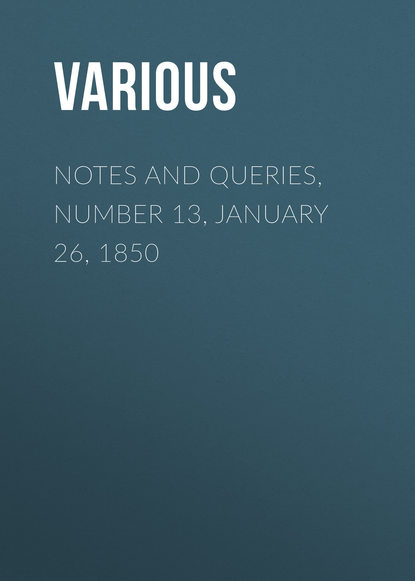По всем вопросам обращайтесь на: info@litportal.ru
(©) 2003-2024.
✖
Notes and Queries, Number 13, January 26, 1850
Автор
Год написания книги
2018
Настройки чтения
Размер шрифта
Высота строк
Поля
Paul-Ernest Jablonski's numerous readers need not be told that the said beetle is an Egyptian emblem of the everlasting and universal soul, and that its temple is the equinoctial circle, the upper hemisphere.[1 - Pantheon Ægypt. tom. 1. p. 63.]
As a solar emblem, it offers an instructive object of inquiry to the judicious gleaners of the old world's fascinating nursery traditions. Sicilian Diodorus tells us that the earth's lover, Attis (or Adonis), after his resuscitation, acquired the divine title of PAPAN.[2 - Diodor. Sic. Biblioth. p. 134.] To hazard the inoffensive query, why one of our commonest great beetles is still allowed to figure under so distinguished a name, will therefore reflect no discredit upon a cautious student of nearly threescore years. The very Welsh talked, in William Baxter's time, of "Heaven, as bugarth PAPAN," the sun's ox-stall or resting-place; and here you likewise find his beetle-majesty, in a Low-Norman collection of insular rhymes:—
"Sus l'bord piâsottaient, côte-à-côte,
Les équerbots et leas PAPANS,
Et ratte et rat laissaient leux crotte
Sus les vieilles casses et même dedans."[3 - Rimes Guernesiaises, p. 4.]
By the help of Horapollo, Chiflet's gnostic gems, and other repertories of the same class, one might, peradventure, make a tolerable case in favour of the mythological identity of the legend of Ladybird—that is, the sun-chafer, or barn-bie, the fire-fly, "whose house is burnt, and whose bairns are ten," of course the first ten days of the Egyptian year[4 - Or the dog-days. Each sign has three Decans, or captains of ten.]—with the mystical stories of the said black or dark blue lords of radiance, Pân and Papân.
The Egyptians revere the beetle as a living and breathing image of the sun, quoth Porphyry.[5 - Porphyr. apud Euseb. Præp. iii. 4.] That will account for this restless delver's extraordinary talismanic renown. I think the lady-bird is "the speckled beetle" which was flung in hot water to avert storms.[6 - Plin. Nat. Hist. lib. 37. cap. 10.] Pignorius gives us the figure of the beetle, crowned with the sun, and encircled with the serpent of eternity; while another, an onyx in the collection of Abraham Gorlæus, threatens to gnaw at a thunderbolt.[7 - Chiflet, p. 133. A genuine cockroach, and a formidable one. I think the English word of Spanish origin.]
Reuven's book on the Egyptian Museum, which I have not seen, notices an invocation to "the winged beetle, the monarch ([Greek: tyrannos]) of mid-heaven," concluding with a devout wish that some poor creature "may be dashed to pieces."
Can any of your readers inform me what is meant by "the blood of the Phuôn?"
Yours truly,
?
St. Martin's, Guernsey, Jan. 9. 1850.
EXTRACTS FROM CHURCHWARDENS' ACCOUNTS OF ST. MARGARET'S, WESTMINSTER—WEIGHT OF BELLS IN ANCIENT TIMES—HISTORY OF A ROOD-LOFT
I send you a few Notes, collected out of the Churchwardens' Accounts of St. Margaret's, Westminster.
1stly. Some regarding the weight of bells in ancient days:—
"1526. The first bell weith ccccc lb.
The second bell weith ccccccxxj lb.
The third bell weith ixCvj lb.
The fourthe bell weith M.x lb.
The fyfthe belonging to our grete Lady
Bretherhed MvjCxiiij lb.
The sume of all the weight MMMMVIIC Li lb.
"1592. The broken Tennor waied xvjCxxj lb.
The new tennor ys. xiijC di
The greatest bell ys xxjC and di at lvjs. the C.
The iiij bell ys xvijC and di and xiiij lb.
The xiiij bell taken awaie was xiijC di.
The ij bell carried awaie was viijCiij qters.
The new bell viijC di.
Som totall of the bells, yron, tymber, and
workmanshipp lxxvl. vs. vd."
This appears to have been a sorry bargain, for soon after occur sad complaints of these bells, "very falsly and deceytfully made by Valentyne Trever." Perhaps your correspondent "CEPHAS" may explain the following entry:—
"1846. Item, paid for makying of a newe clapper to
Judas bell xd."
2ndly. Some entries, which make up a little history of a rood-loft:—
"1460. Item, sol' pro le skoryng de la belles sup' le
Rode lofte iiijd.
"1480. Item, paide for a doore in the rode lofte to
save and kepe the people from the Orgayns
xijd.
Item, paide to a carpynter for makyng of the
Crucyfix and the beme He standeth upon xls.
Item, paide for kervying of Mary and John
and the makyng newe xxxiijs. iiijd.
Item, for gilding of the same Mary and John
and the Crosse and iiij'or Evangelysts
vjl. vjs. viijd.
"1530. Item, payd to a labourer for helpying up the
Roode Loft into the stepull viijd.
"1534. Payd for a present for Mr. Alford and Mr.











